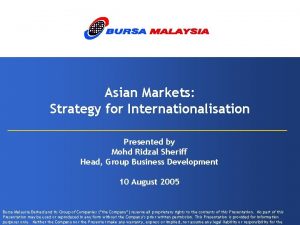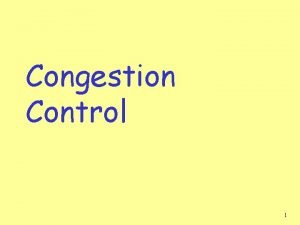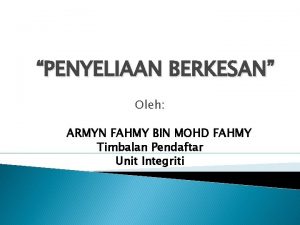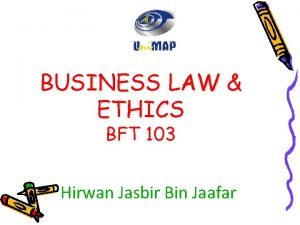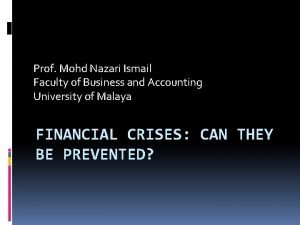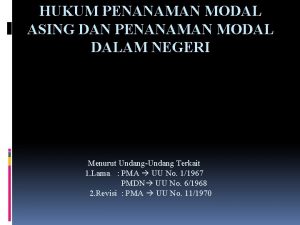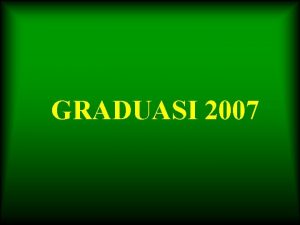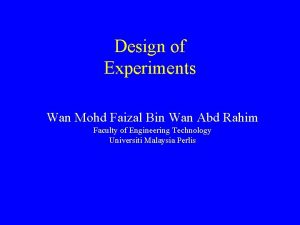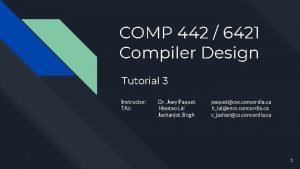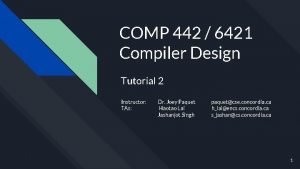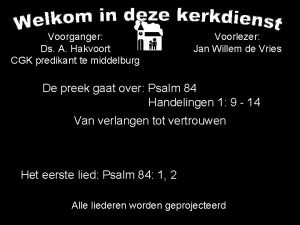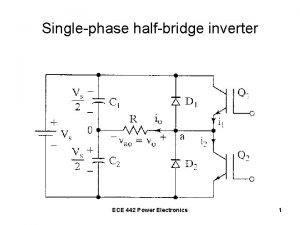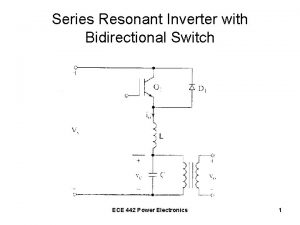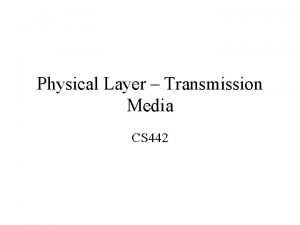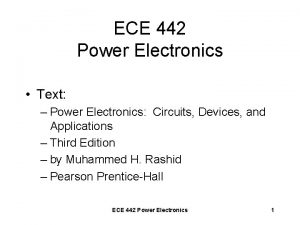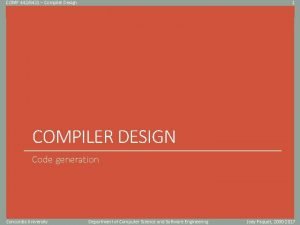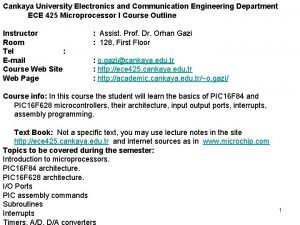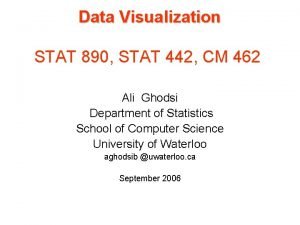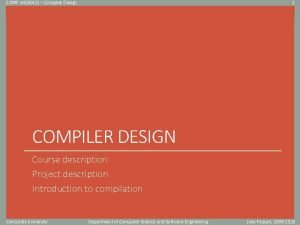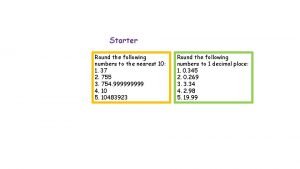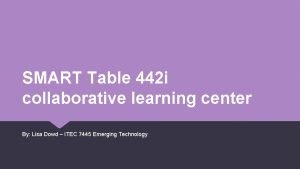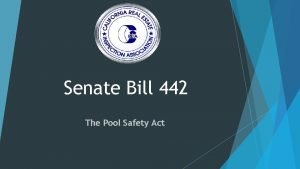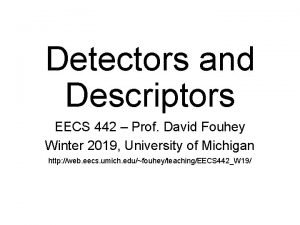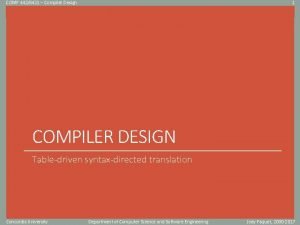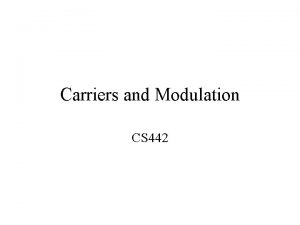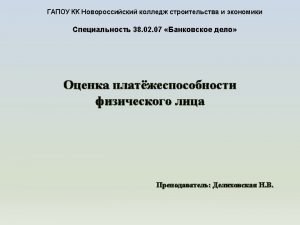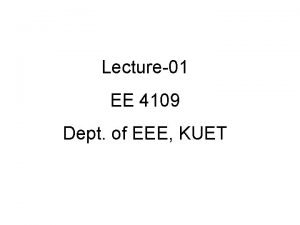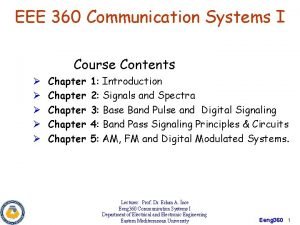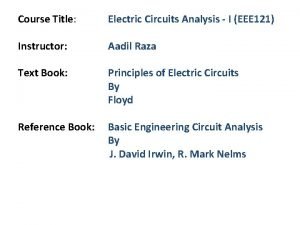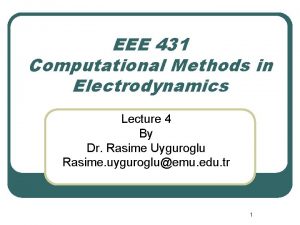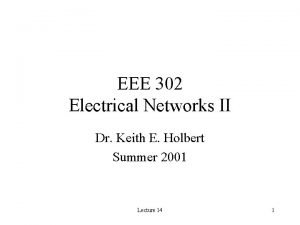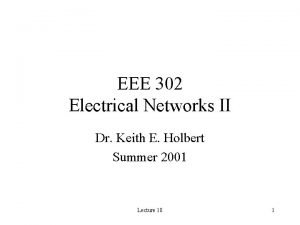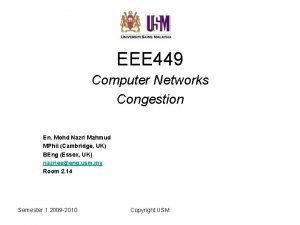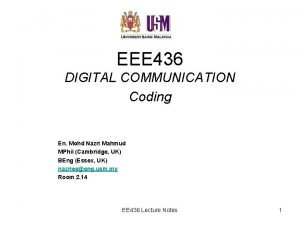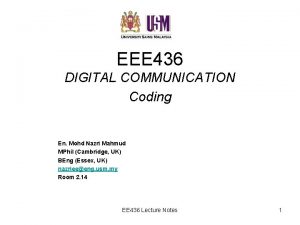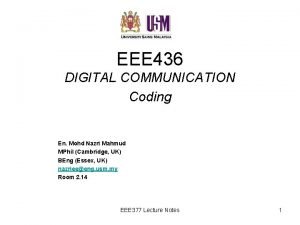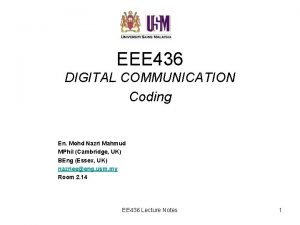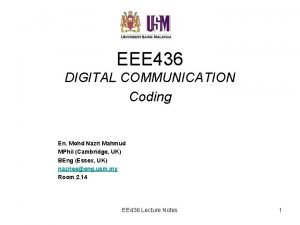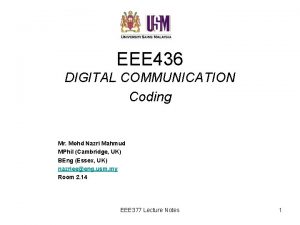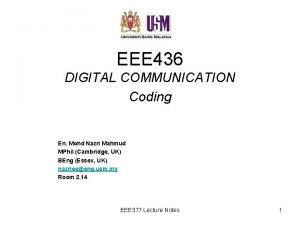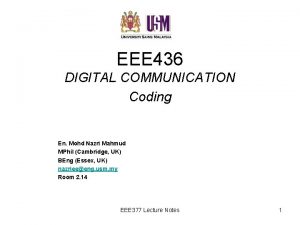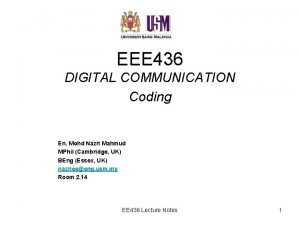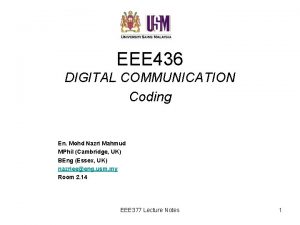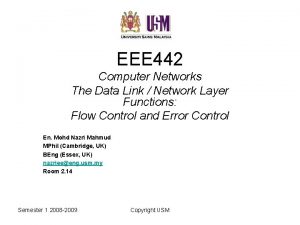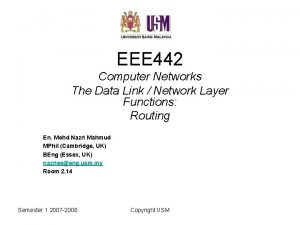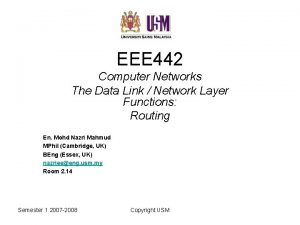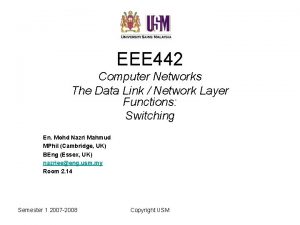EEE 442 Computer Networks Congestion En Mohd Nazri
















































- Slides: 48

EEE 442 Computer Networks Congestion En. Mohd Nazri Mahmud MPhil (Cambridge, UK) BEng (Essex, UK) nazriee@eng. usm. my Room 2. 14 Semester 1 2007 -2008 Copyright USM

What Is Congestion? • congestion occurs when the no of packets being transmitted through the network approaches the packet handling capacity of the network • congestion control aims to keep no of packets below a level at which performance falls off dramatically • a data network is a network of queues • generally 80% utilization is critical • finite queues mean data may be lost Semester 1 2007 -2008 Copyright USM

Queues at a Node Semester 1 2007 -2008 Copyright USM

Interaction of Queues Semester 1 2007 -2008 Copyright USM

Ideal Network Utilization Semester 1 2007 -2008 Copyright USM

Effects of Congestion No Control Semester 1 2007 -2008 Copyright USM

Mechanisms for Congestion Control Semester 1 2007 -2008 Copyright USM

Backpressure • if node becomes congested it can slow down or halt flow of packets from other nodes – cf. backpressure in blocked fluid pipe – may mean that other nodes have to apply control on incoming packet rates – propagates back to source • can restrict to high traffic logical connections • used in connection oriented nets that allow hop by hop congestion control (eg. X. 25) • not used in ATM nor frame relay • only recently developed for IP Semester 1 2007 -2008 Copyright USM

Choke Packet • a control packet – generated at congested node – sent to source node – eg. ICMP source quench • from router or destination • source cuts back until no more source quench message • sent for every discarded packet, or anticipated • is a rather crude mechanism Semester 1 2007 -2008 Copyright USM

Implicit Congestion Signaling • • transmission delay increases with congestion hence a packet may be discarded source detects this implicit congestion indication useful on connectionless (datagram) networks – eg. IP based • (TCP includes congestion and flow control - see chapter 17) • used in frame relay LAPF Semester 1 2007 -2008 Copyright USM

Explicit Congestion Signaling • network alerts end systems of increasing congestion • end systems take steps to reduce offered load • Backwards – congestion avoidance notification in opposite direction to packet required • Forwards – congestion avoidance notification in same direction as packet required Semester 1 2007 -2008 Copyright USM

Explicit Signaling Categories • Binary – a bit set in a packet indicates congestion • Credit based – indicates how many packets source may send – common for end to end flow control • Rate based – supply explicit data rate limit – nodes along path may request rate reduction – eg. ATM Semester 1 2007 -2008 Copyright USM

Traffic Management • fairness – provide equal treatment of various flows • quality of service – different treatment for different connections • reservations – traffic contract between user and network – carry best-effort or discard excess traffic Semester 1 2007 -2008 Copyright USM

Congestion Control in Packet Switched Networks • send control packet to some or all source nodes – requires additional traffic during congestion • rely on routing information – may react too quickly • end to end probe packets – adds to overhead • add congestion info to packets in transit – either backwards or forwards Semester 1 2007 -2008 Copyright USM

Frame Relay Congestion Control • minimize discards • maintain agreed Qo. S • minimize probability of one end user monopoly • simple to implement • create minimal additional traffic • distribute resources fairly • limit spread of congestion • operate effectively regardless of traffic flow • minimum impact on other systems • minimize variance in Qo. S Semester 1 2007 -2008 Copyright USM

FR Control Techniques • difficult for frame-relay • joint network & end-system responsibility • techniques: – discard strategy – congestion avoidance – explicit signaling – congestion recovery – implicit signaling mechanism Semester 1 2007 -2008 Copyright USM

Traffic Rate Management • must discard frames to cope with congestion – arbitrarily, no regard for source – no reward for restraint so end systems transmit as fast as possible – Committed information rate (CIR) • data in excess of this liable to discard • not guaranteed in extreme congestion situations • aggregate CIR should not exceed physical data rate • Committed burst size • Excess burst size Semester 1 2007 -2008 Copyright USM

Operation of CIR Semester 1 2007 -2008 Copyright USM

Relationship Among Congestion Parameters Semester 1 2007 -2008 Copyright USM

Congestion Avoidance using Explicit Signaling • network alerts end systems of growing congestion using – backward explicit congestion notification – forward explicit congestion notification • frame handler monitors its queues • may notify some or all logical connections • user response reduce rate Semester 1 2007 -2008 Copyright USM

ATM Traffic Management • high speed, small cell size, limited overhead bits • still evolving • reasons existing tools are inadequate for ATM – majority of traffic not amenable to flow control – feedback slow due to reduced transmission time compared with propagation delay – wide range of application demands – different traffic patterns – different network services – high speed switching and transmission increases volatility Semester 1 2007 -2008 Copyright USM

Latency/Speed Effects • consider ATM at 150 Mbps • takes ~2. 8 x 10 -6 seconds to insert single cell • time to traverse network depends on propagation delay and switching delay • assume propagation at two-thirds speed of light • if source and destination on opposite sides of USA, propagation time ~ 48 x 10 -3 seconds • given implicit congestion control, by the time dropped cell notification has reached source, 7. 2 x 106 bits have been transmitted • this is not a good strategy for ATM Semester 1 2007 -2008 Copyright USM

Cell Delay Variation • • • for ATM voice/video, data is a stream of cells delay across network must be short rate of delivery must be constant there will always be some variation in transit delay cell delivery to application so that constant bit rate can be maintained to application Semester 1 2007 -2008 Copyright USM

Timing of CBR Cells Semester 1 2007 -2008 Copyright USM

Network Contribution to Cell Delay Variation • in packet switched networks is due to queuing delays and routing decision time • in Frame relay networks is similar • in ATM networks – less than frame relay – ATM protocol designed to minimize processing overheads at switches – ATM switches have very high throughput – only noticeable delay is from congestion – must not accept load that causes congestion Semester 1 2007 -2008 Copyright USM

Cell Delay Variation At The UNI • application produces data at fixed rate • 3 layers of ATM processing causes delay – interleaving cells from different connections – operation and maintenance cell interleaving – if using synchronous digital hierarchy frames, these are inserted at physical layer • cannot predict these delays Semester 1 2007 -2008 Copyright USM

Origins of Cell Delay Variation Semester 1 2007 -2008 Copyright USM

Traffic and Congestion Control Framework • ATM layer traffic and congestion control should support Qo. S classes for all foreseeable network services • should not rely on AAL protocols that are network specific, nor higher level application specific protocols • should minimize network and end to end system complexity Semester 1 2007 -2008 Copyright USM

Timings Considered • timing intervals considered: – – cell insertion time round trip propagation time connection duration long term • traffic control strategy then must: – determine whether a given new connection can be accommodated – agree performance parameters with subscriber • now review various control techniques Semester 1 2007 -2008 Copyright USM

Resource Management Using Virtual Paths • separate traffic flow according to service characteristics on a virtual path – user to user application – user to network application – network to network application • Qo. S parameters concerned with are: – cell loss ratio – cell transfer delay – cell delay variation Semester 1 2007 -2008 Copyright USM

Configuration of VCCs and VPCs Semester 1 2007 -2008 Copyright USM

Allocating VCCs within VPC • all VCCs within VPC should experience similar network performance • options for allocation: – aggregate peak demand • set VPC capacity to total of all peak VCC rates • will meet peak demands, but often underutilized – statistical multiplexing • set VPC capacity to more than average VCC rates • will see greater variation but better utilization Semester 1 2007 -2008 Copyright USM

Connection Admission Control • first line of defense • user specifies traffic characteristics for new connection (VCC or VPC) by selecting a Qo. S • network accepts connection only if it can meet the demand • traffic contract – – peak cell rate cell delay variation sustainable cell rate burst tolerance Semester 1 2007 -2008 Copyright USM

Usage Parameter Control • UPC function monitors a connection to ensure traffic obeys contract • purpose is to protect network resources from overload by one connection • done on VCC and VPC • peak cell rate and cell delay variation • sustainable cell rate and burst tolerance • UPC discards cells outside traffic contract Semester 1 2007 -2008 Copyright USM

Selective Call Discard • when network at point beyond UPC discards (CLP=1) cells • aim to discard lower-priority cells when congested to protect higher-priority cells – note. can’t distinguish between cells originally labeled lower priority, verses those tagged by UPC function Semester 1 2007 -2008 Copyright USM

Traffic Shaping • • • UPC provides a form of traffic policing can be desirable to also shape traffic smoothing out traffic flow reducing cell clumping token bucket Semester 1 2007 -2008 Copyright USM

Token Bucket for Traffic Shaping Semester 1 2007 -2008 Copyright USM

GFR Traffic Management • guaranteed frame rate (GFR) as simple as UBR from end system viewpoint • places modest requirements on ATM network • end system does no policing or shaping of traffic • may transmit at line rate of ATM adaptor • no guarantee of delivery – so higher layer (eg. TCP) must do congestion control • user can reserve capacity for each VC – ensures application can send at min rate with no loss – if no congestion, higher rates maybe used Semester 1 2007 -2008 Copyright USM

Frame Recognition • GFR recognizes frames as well as cells • when congested, network discards whole frame rather than individual cells • all cells of a frame have same CLP bit setting • CLP=1 AAL 5 frames lower priority (best effort) • CLP=0 frames minimum guaranteed capacity Semester 1 2007 -2008 Copyright USM

GFR Contract Parameters • • • Peak cell rate (PCR) Minimum cell rate (MCR) Maximum burst size (MBS) Maximum frame size (MFS) Cell delay variation tolerance (CDVT) Semester 1 2007 -2008 Copyright USM

Components of GFR System Supporting Rate Guarantees Semester 1 2007 -2008 Copyright USM

Tagging and Policing • discriminates between frames that conform to contract and those that don’t • set CLP=1 on all cells in frame if not – gives lower priority • maybe done by network or source • network may discard CLP=1 cells – policing Semester 1 2007 -2008 Copyright USM

Buffer Management • deals with treatment of buffered cells • congestion indicated by high buffer occupancy • will discard tagged cells in preference to untagged cells – including ones already in buffer to make room • may do per VC buffering for fairness • cell discard based on queue-specific thresholds Semester 1 2007 -2008 Copyright USM

Scheduling • • • preferential treatment to untagged cells separate queues for each VC make per-VC scheduling decisions enables control of outgoing rate of VCs get fair capacity allocation still meet contract Semester 1 2007 -2008 Copyright USM

GFC Conformance Definition • • • UPC function monitors each active VC to ensure traffic conforms to contract tag or discard nonconforming cells frame conforms if all cells conform a cell conforms if: – rate of cells is within contract – all cells in frame have same CLP – frame satisfies MFS parameter • check if either last cell in frame or cell count < MFS Semester 1 2007 -2008 Copyright USM

Qo. S Eligibility Test • two stage filtering process • a frame is tested for conformance to contract – if not, may discard or tag – set upper bound & penalize cells above upper bound – do expect attempt to deliver tagged cells • determine frames eligible for Qo. S guarantees – under GFR contract for VC – set lower bound on traffic – frames in traffic flow below threshold are eligible Semester 1 2007 -2008 Copyright USM

GFR VC Frame Categories • nonconforming frame – cells of this frame will be tagged or discarded • conforming but ineligible frames – cells will receive a best-effort service • conforming and eligible frames – cells will receive a guarantee of delivery • form of cell rate algorithm is used Semester 1 2007 -2008 Copyright USM

Summary • • • congestion effects congestion control traffic management frame relay congestion control ATM congestion control Semester 1 2007 -2008 Copyright USM
 Mohd ridzal bin mohd sheriff
Mohd ridzal bin mohd sheriff Circumciliary congestion and conjunctival congestion
Circumciliary congestion and conjunctival congestion General principles of congestion control
General principles of congestion control A switched wan is normally implemented as a network
A switched wan is normally implemented as a network Backbone networks in computer networks
Backbone networks in computer networks Syahid mohd zain
Syahid mohd zain Armyn fahmy mohd fahmy
Armyn fahmy mohd fahmy Mohd talib latif
Mohd talib latif Norizan mohd noor
Norizan mohd noor Contract first
Contract first Prof nazari ismail
Prof nazari ismail Hiley formula
Hiley formula Putra mohd aidil rizal
Putra mohd aidil rizal Gayatiri
Gayatiri Wan mohd faizal
Wan mohd faizal I am a bird by kathrina
I am a bird by kathrina Eecs442
Eecs442 Compiler design tutorial
Compiler design tutorial Comp 442
Comp 442 Psalm 73 liedboek
Psalm 73 liedboek Power electronics
Power electronics Ece 442
Ece 442 442 media
442 media Ee 442
Ee 442 Power electronics
Power electronics Ece 442
Ece 442 Comp 442
Comp 442 Ece 442 çankaya
Ece 442 çankaya Me 442
Me 442 Me 442
Me 442 Controlece
Controlece Stat 442
Stat 442 Comp 442
Comp 442 443 to the nearest 10
443 to the nearest 10 Smart table 442i
Smart table 442i California swimming pool safety act 1998
California swimming pool safety act 1998 Eecs 442
Eecs 442 Ece 442
Ece 442 Comp 442
Comp 442 Cs 442
Cs 442 David fouhey
David fouhey Eecs 442
Eecs 442 Kuet eee
Kuet eee Analog communication
Analog communication Ankara university
Ankara university Eee 121
Eee 121 Eee 431
Eee 431 Eee 302
Eee 302 Eee 302
Eee 302
